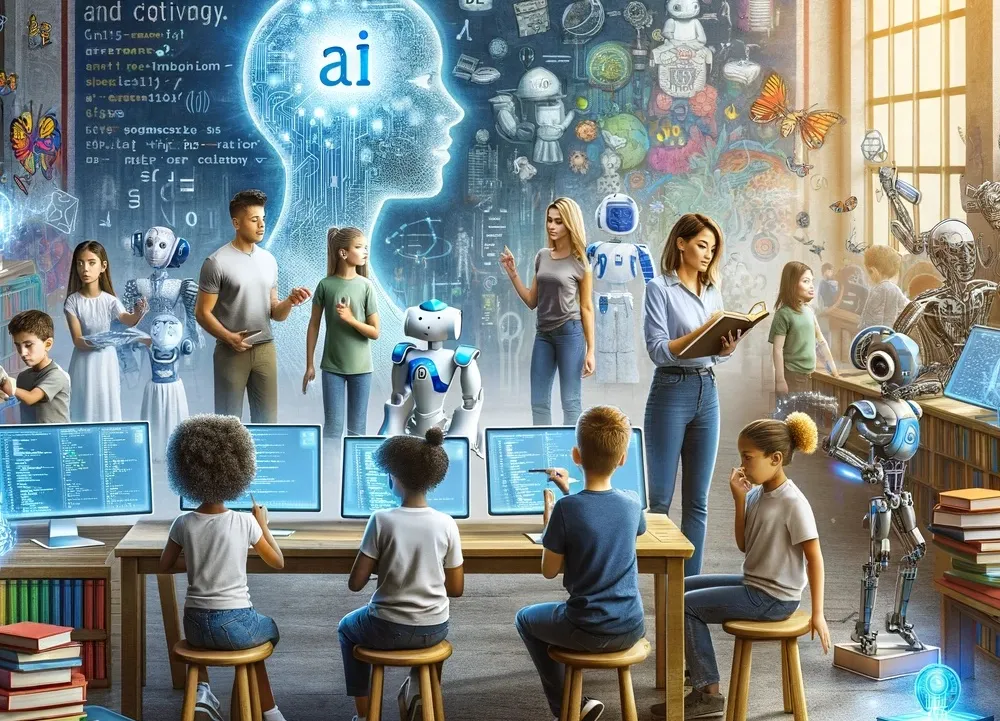In 2025, a dramatic shift is underway in American education: AI literacy has gone mainstream. With artificial intelligence now embedded in every major industry, from healthcare to entertainment, students across the U.S. are no longer asking if they should learn AI—they’re asking how soon they can get started.
From high school classrooms to university lecture halls, students are enrolling in AI-focused programs in record numbers. But it’s not just about coding. Today’s learners are as focused on ethical implications, societal impacts, and career adaptability as they are on neural networks and natural language processing.
As the United States adapts to a workforce transformed by automation, AI fluency is becoming a form of economic survival—and a civic responsibility.
📈 AI Literacy: A National Priority
The growth of AI education began gradually in the early 2020s but surged by mid-decade. By 2025:
- 72% of U.S. high school students have been exposed to AI curricula before graduation.
- Over 60% of college freshmen cite AI literacy as a deciding factor in their major.
- Community colleges and trade schools are offering AI and machine learning (ML) certifications to adults retraining for future-proof jobs.
This wave of interest is the result of national education policies, massive investments from tech companies, and a societal shift toward recognizing AI as a “basic skill” much like reading, writing, or math.
The Department of Education, in partnership with NSF and the Office of Science and Technology Policy, has supported AI curriculum development for K–12 through postsecondary levels, with a focus on equity, access, and responsible use.
🧠 It’s Not Just About Tech—It’s About Ethics
While technical know-how remains crucial, today’s students are deeply interested in AI ethics, transparency, and human-centered design.In the spring of 2025, a study conducted among college students found: 84% believe AI should be taught alongside ethics and philosophy.
- 68% fear job displacement without proper policy safeguards.
- 55% say AI’s role in misinformation and surveillance affects their trust in institutions.
As a result, institutions are expanding interdisciplinary programs where computer science, law, political science, psychology, and sociology intersect. Courses like AI & Inequality, Algorithmic Bias, and AI & Democracy are now core to many liberal arts and STEM pathways.

💼 Career Security in the Age of Automation
One of the clearest motivations behind this AI boom is career security. The labor market in 2025 continues to evolve rapidly under automation, with traditional roles in administration, finance, and manufacturing undergoing major disruption.
AI-literate students are positioning themselves for:
- AI governance and regulatory roles
- Prompt engineering and model training
- Human-AI collaboration design
- Technical communications for AI systems
- Ethical auditing of AI tools
Even non-technical fields are adapting. Marketing, journalism, education, and mental health are seeing a rise in AI-augmented professions that require employees to interpret or work alongside intelligent systems.
🏫 AI Education Begins in K–12
In the U.S., public schools are now adopting AI literacy standards at a rapid pace. As part of the AI for All Initiative, 38 states have implemented AI modules in middle and high schools. These cover:
- Basic machine learning concepts
- Understanding how chatbots and image generators work
- Recognizing algorithmic bias
- Ethical challenges in facial recognition and surveillance
Educators are being trained not only to teach the technology but to guide students in critical thinking and social awareness around AI use.
In one Georgia high school, a required course titled AI & Society teaches students how to detect deepfakes, analyze algorithmic recommendation systems, and debate ethical dilemmas like AI in warfare or policing.
🤖 Higher Education Adapts—Fast
Universities are overhauling outdated CS programs in favor of AI-integrated learning across disciplines. Some of the key shifts include:
- All undergraduates, regardless of major, must be fluent in AI
- Partnering with tech firms for real-time industry-aligned training
- Creating AI-humanities hybrid degrees
- Hosting AI-focused ethics symposia and hackathons
At MIT, Stanford, and Howard University, AI literacy courses are now required for graduation across all disciplines, not just STEM.
Meanwhile, community colleges and trade programs are offering short-term AI certifications that empower non-traditional students to reskill quickly and access competitive salaries in automation-proof sectors.
🌍 A Global Race for Responsible AI Talent
Internationally, countries like China, India, and the UK are investing heavily in AI talent. The U.S., while a leader in innovation, has faced pressure to close its skills gap and ensure its workforce is ready for global competition.
American policymakers now view AI literacy as a national security and economic imperative, with bipartisan support behind initiatives such as:
- The AI Workforce Readiness Act
- The AI Literacy in Schools Act
- New federal funding for AI apprenticeships and bootcamps
These efforts aim not only to protect jobs but to ensure that AI development in the U.S. reflects democratic values and human rights.
🧩 Inclusion, Access, and Equity
A critical focus of the AI literacy movement is ensuring equal access. Communities historically left behind by tech revolutions—especially in rural areas and underserved urban schools—are now central to AI literacy planning.
Tech firms, nonprofits, and public institutions are working together to provide:
- Free AI courses and micro-credentials online
- Devices and internet access for AI projects
- Outreach initiatives to encourage minority and female students to pursue careers in AI
Initiatives like “AI Girls Rock!”and “Latinx Leaders in AI” are significantly contributing to the future AI workforce’s increased diversity.
🛡️ AI as a Civic Skill
Beyond the job market, AI is increasingly seen as a civic skill. Just as digital literacy helped people navigate the early internet era, AI literacy is now essential to understanding:
- How content is personalized (and manipulated)
- How algorithms shape justice, hiring, housing, and healthcare
- How misinformation spreads via AI-generated media
By giving students the tools to critically engage with AI, schools are helping to create more informed citizens who can participate in democratic discourse and shape the future of AI policy.
FAQs: AI Literacy Among U.S. Students in 2025
1. What is AI literacy?
AI literacy refers to the ability to understand, use, critique, and design artificial intelligence tools. It includes knowledge of how algorithms work, their ethical implications, and how to collaborate with AI systems in everyday life and work.
2. Why is AI education becoming a priority for students?
Students see AI as key to career security, civic awareness, and personal agency. As AI touches nearly every job sector, understanding it is becoming a necessary life skill—similar to digital literacy in past decades.
3. Are AI classes only for computer science students?
No. AI literacy is being taught across all disciplines, including business, journalism, healthcare, law, and the arts. Many schools now require all students to complete at least one AI-related course.
4. What are students learning in AI courses?
Core topics include machine learning basics, ethical AI design, bias and fairness, AI in media, prompt engineering, and real-world applications such as recommendation systems or generative models.
5. Is AI literacy being taught in K–12 schools too?
Yes. Middle and high schools in many states now include AI modules in STEM or civics curricula. Programs cover both technical understanding and societal impacts.
6. Can you get a job without knowing AI?
Yes—but having AI literacy can significantly boost career resilience and competitiveness. Even in non-technical jobs, working with or managing AI tools is becoming standard.




